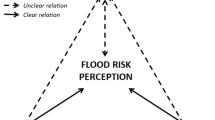Abstract
Historically, severe floods have caused great human and financial losses. Therefore, the flood frequency analysis based on the flood multiple variables including flood peak, volume and duration poses more motivation for hydrologists to study. The main goal of this paper is conducting a tri-variate flood frequency analysis through simultaneously processing the three main variables of any flood event. In addition to this analysis, three bi-variate flood frequency analyses are also performed considering the variables pairwise. Meanwhile, the Archimedean copula functions are employed to conduct such analyses, and finally compared based on their performance in estimating the accurate and reliable flood frequencies. Bivariate and trivariate flood frequency analysis and modeling using Archimedean copula functions is focused. For this purpose, the annual flood data over a 55-year historical period recorded at the Dez Dam hydrometric station were used. According to the goodness-of-fit criteria along with the analytical tail dependence results based on the extreme value theory, the Frank function built upon the couple of the flood peak-volume and the couple of the flood peak-duration as well as the Clayton function built upon the flood volume-duration were identified to be the best copula families to be adopted. The trivariate analysis was conducted and the Clayton family was chosen as the best copula function. Thereafter, the common and conditional cumulative probability distribution functions were built and analyzed to determine the periodic "and", "or" and "conditional" bivariate and trivariate flood return periods. The results suggest that the bivariate conditional return period obtained for short-term periods is more reliable than the trivariate conditional return period. Additionally, the trivariate conditional return period calculated for long-term periods is more reliable than the bivariate conditional return period.













Similar content being viewed by others
References
Ashkar F (1980) Partial duration series models for flood analysis: école polytechnique de montréal
De Michele C, Salvadori G (2003) A generalized Pareto intensity-duration model of storm rainfall exploiting 2-copulas. J Geophys Res Atmos. https://doi.org/10.1029/2002JD002534
De Michele C, Salvadori G, Canossi M, Petaccia A, Rosso R (2005) Bivariate statistical approach to check adequacy of dam spillway. J Hydrol Eng 10(1):50–57
Favre AC, El Adlouni S, Perreault L, Thiémonge N, Bobée B (2004) Multivariate hydrological frequency analysis using copulas. Water Resour Res. https://doi.org/10.1029/2003WR002456
Felfelani F, Movahed AJ, Zarghami M (2013) Simulating hedging rules for effective reservoir operation by using system dynamics: a case study of Dez Reservoir, Iran. Lake Reserv Manag 29(2):126–140
Frahm G, Junker M, Schmidt R (2005) Estimating the tail-dependence coefficient: properties and pitfalls. Insur Math Econ 37(1):80–100
Francisco Nunes Correia (1987) Multivariate partial duration series in flood risk analysis. In: Singh Vijay P (ed) Hydrologic frequency modeling. Springer, Dordrecht, pp 541–554
Genest C, Favre AC, Béliveau J, Jacques C (2007) Metaelliptical copulas and their use in frequency analysis of multivariate hydrological data. Water Resour Res. https://doi.org/10.1029/2006WR005275
Gringorten II (1963) A plotting rule for extreme probability paper. J Geophys Res 68(3):813–814
Joe H (1997) Multivariate models and multivariate dependence concepts. CRC Press
Klein B, Pahlow M, Hundecha Y, Schumann A (2010) Probability analysis of hydrological loads for the design of flood control systems using copulas. J Hydrol Eng 15(5):360–369
Li T, Wang S, Fu B, Feng X (2020) Frequency analyses of peak discharge and suspended sediment concentration in the United States. J Soils Sediments 20(2):1157–1168
Nashwan MS, Ismail T, Ahmed K (2018) Flood susceptibility assessment in Kelantan river basin using copula. Int J Eng Technol 7(2):584–590
Nelsen RB (2006) An Introduction to Copulas. Springer, New York (MR2197664)
Sackl B, Bergmann H (1987) A bivariate flood model and its application. In: Singh Vijay P (ed) Hydrologic frequency modeling. Springer, pp 571–582
Salari M, Akhond Ali AM, Adib A, Dneshkhah AR (2015) Bivariate flood frequency analysis using the copula functions. Irrig Sci Eng 37(4):29–38
Salvadori G, De Michele C (2007) On the use of copulas in hydrology: theory and practice. J Hydrol Eng 12(4):369–380
Salvadori G, De Michele C (2010) Multivariate multiparameter extreme value models and return periods: a copula approach. Water Resour Res. https://doi.org/10.1029/2009WR009040
Serinaldi F (2008) Analysis of inter-gauge dependence by Kendall’s τ K, upper tail dependence coefficient, and 2-copulas with application to rainfall fields. Stoch Env Res Risk Assess 22(6):671–688
She D, Xia J (2018) Copulas-based drought characteristics analysis and risk assessment across the loess plateau of China. Water Resour Manage 32(2):547–564
Shiau J-T, Wang H-Y, Tsai C-T (2010) Copula-based depth-duration-frequency analysis of typhoons in Taiwan. Hydrol Res 41:414–423
Silverman BW (1986) Density estimation for statistics and data analysis. CRC Press
Sklar M (1959) Fonctions de repartition an dimensions et leurs marges. Publ Inst Stat Univ Paris 8:229–231
Volpi E, Fiori A (2012) Design event selection in bivariate hydrological frequency analysis. Hydrol Sci J 57(8):1506–1515
Yue S, Ouarda T, Bobée B, Legendre P, Bruneau P (1999) The Gumbel mixed model for flood frequency analysis. J Hydrol 226(1–2):88–100
Zhang L, Singh V (2006) Bivariate flood frequency analysis using the copula method. J Hydrol Eng 11(2):150–164
Zhang L, Singh VP (2007) Trivariate flood frequency analysis using the Gumbel-Hougaard copula. J Hydrol Eng 12(4):431–439
Zhang Q, Zhang L, She D, Wang S, Wang G, Zeng S (2021) Automatic procedure for selecting flood events and identifying flood characteristics from daily streamflow data. Environ Modell Softw. https://doi.org/10.1016/j.envsoft.2021.105180
Funding
The authors have not disclosed any funding.
Author information
Authors and Affiliations
Corresponding author
Ethics declarations
Conflict of interest
The authors have not disclosed any competing interests.
Additional information
Publisher's Note
Springer Nature remains neutral with regard to jurisdictional claims in published maps and institutional affiliations.
Appendix
Rights and permissions
About this article
Cite this article
Klaho, M.H., Safavi, H.R., Golmohammadi, M.H. et al. Comparison between bivariate and trivariate flood frequency analysis using the Archimedean copula functions, a case study of the Karun River in Iran. Nat Hazards 112, 1589–1610 (2022). https://doi.org/10.1007/s11069-022-05240-y
Received:
Accepted:
Published:
Issue Date:
DOI: https://doi.org/10.1007/s11069-022-05240-y




